|

Reference Guide
|
|
How To / Using the Printer Driver with Macintosh
Making Changes to Printer Settings
 Choosing the print quality
Choosing the print quality
 Resizing printouts
Resizing printouts
 Modifying the print layout
Modifying the print layout
 Using watermarks
Using watermarks
Choosing the print quality
You can change the print quality or resolution of printouts to favor speed or detail. If you need high quality output, choose a higher number. Please note that doing so reduces the print speed.
There are three levels of print output, 600 dpi, Class 1200 dpi, and 1200 dpi. Class 1200 dpi provides high quality printing results on par with 1200 dpi with the Enh.MG and RITech functions (under 600 dpi).
 |
Open the Basic Settings dialog box.
|
 |
Select Automatic on Print Quality, and select the desired printing resolution from the Resolution drop-down list.
|
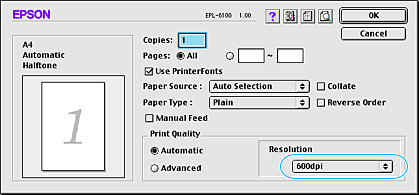
 |  |
Note:
|
 |  | -
If printing is unsuccessful or a memory-related error message appears, selecting a lower resolution may allow printing to proceed.
|
 |  | -
For details of the Enh.MG or RITech functions, see the Online Help.
|

[Top]
Resizing printouts
The Fit to page function in the Layout dialog box allows you to have your documents enlarged or reduced during printing according to the specified paper size.
 |
Note:
|
 | -
The enlarging or reducing rate is automatically specified according to the paper size selected in the Paper Setting dialog box.
|
 | -
The modifying or reducing rate selected in the Paper Setting dialog box is not available.
|
 |
Open the Layout dialog box.
|
 |
Select the Fit to Page check box.
|
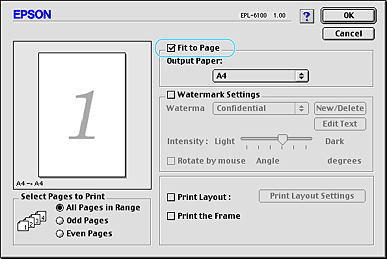
 |
Select the desired paper size from the Output Paper drop-down list. The page will be printed to fit on the paper you have selected.
|
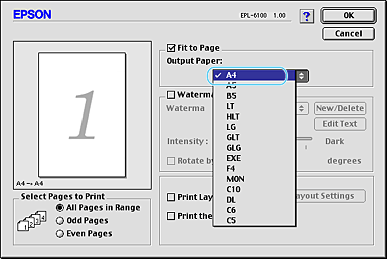
 |
Click OK to accept settings.
|

[Top]
Modifying the print layout
"Layout printing" prints either two or four pages onto a single page and to specify the printing order, automatically resizing each page to fit the specified paper size. You can also choose to print documents surrounded by a frame.
 |
Open the Layout dialog box.
|
 |
Select the Print Layout check box, then click Print Layout Settings. The Print Layout Settings dialog box appears.
|
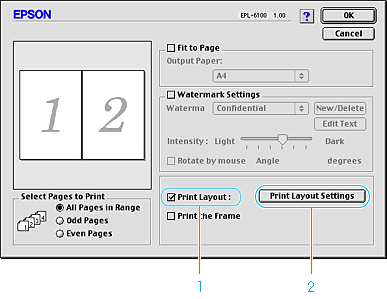
 |
Select the number of pages you want to print on one sheet of paper.
|
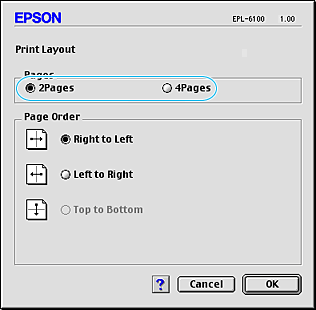
 |
Select the page order in which the pages are printed on each sheet.
|
 |  |
Note:
|
 |  |
Page Order choices depend on Pages selected in Orientation.
|
 |
Click OK to close the Print Layout Settings dialog box.
|
 |
Select the Print the Frame check box in the Layout dialog box when you want to print the pages surrounded by a frame.
|
 |
Click OK in the Layout dialog box to accept the settings.
|

[Top]
Using watermarks
Follow the steps to use a watermark on your document. In the Layout dialog box, you can select from a list of predefined watermarks, or you can select a bitmap (PICT) file or a text file as your own custom watermark. The Layout dialog box also allows you to make a variety of detailed watermark settings. For example, you can select the size, intensity, and position of your watermark.
 |
Open the Layout dialog box.
|
 |
Select the Watermark Settings check box.
|
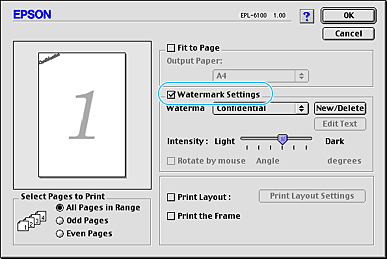
 |
Select a watermark from the Watermark drop-down list.
|
 |
Select the location on the page where you want to print the watermark by dragging the watermark image on the preview window. Also, when you want to resize the watermark, drag its handle.
|
 |
Adjust the image intensity of the watermark with the Intensity slider bar.
|
 |
For a text watermark, you can rotate it by entering the degrees in the Angle box. Or, select the Rotate by mouse check box, and rotate the text watermark with the pointer on the preview window.
|
 |
Click OK to accept the settings.
|
Making a new watermark
To make a text watermark, follow the instructions below:
 |
Open the Layout dialog box.
|
 |
Select the Watermark Settings check box.
|
 |
Click New/Delete.
|
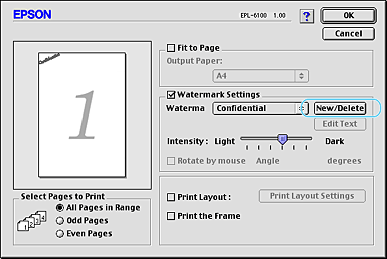
 |
Type the file name in the Name box, and click Add Text.
|
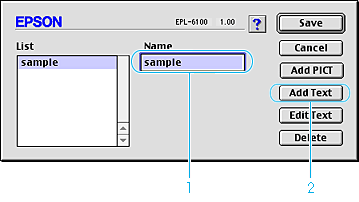
 |
Type the watermark text in the Text box, and select the Font and Style, and then click OK.
|
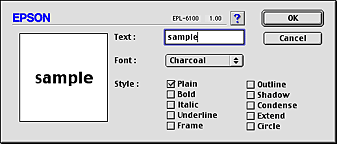
 |
Click Save.
|
 |  |
Note:
|
 |  | -
To edit the saved text watermark, select it from List, and click Edit Text. After editing, be sure to click OK to close the dialog box.
|
 |  | -
To remove the saved text watermark, select it from List, and click Delete. After editing, be sure to click Save to close the dialog box.
|
 |
Click OK on the Layout dialog box. The saved watermark is displayed on the preview window.
|
To make a bitmap watermark, follow the instructions below:
 |  |
Note:
|
 |  |
Before making a custom watermark, you should prepare a bitmap (PICT) file.
|
 |
Open the Layout dialog box.
|
 |
Click New/Delete.
|

 |
Type the file name in the Name box, and click Add PICT.
|
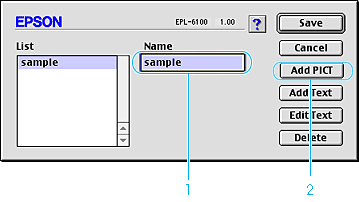
 |
Select the PICT file and click Convert. When you click Create, the watermark is displayed on the preview window.
|
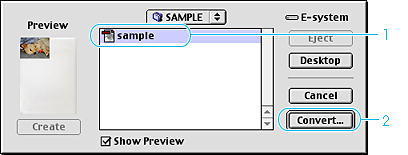
 |
Type the file name in the Name box, and click Save.
|
 |  |
Note:
|
 |  |
To remove the saved watermark, select it from List, and click Delete. After removing it, be sure to click Save to close the dialog box.
|
 |
Click OK on the Layout dialog box. The saved watermark is displayed on the preview window.
|

[Top]
| Version 1.00E, Copyright © 2002, SEIKO EPSON CORPORATION |
Choosing the print quality
Resizing printouts
Modifying the print layout
Using watermarks